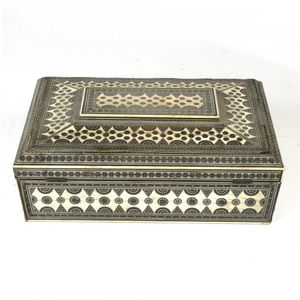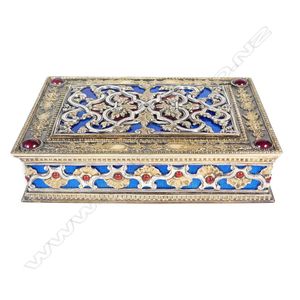18ct Gold and Enamel Embellished Silver Box
You must be a subscriber, and be logged in to view price and dealer details.
Subscribe Now to view actual auction price for this item
When you subscribe, you have the option of setting the currency in which to display prices to $Au, $US, $NZ or Stg.
- Ivory - Ivory is a hard white material that comes from the tusks of elephants, mammoth, walrus and boar, or from the teeth of hippopotamus and whales. The ivory from the African elephant is the most prized source of ivory. Although the mammoth is extinct, tusks are still being unearthed in Russia and offered for sale.
Ivory has been used since the earliest times as a material for sculpture of small items, both in Europe and the east, principally China and Japan.
In Asia ivory has been carved for netsuke, seals, okimono, card cases, fan supports, animals and other figures and even as carved tusks.
In the last 200 years in Europe ivory has been used to carve figures, for elaborate tankards, snuff boxes, cane handles, embroidery and sewing accessories, in jewellery and as inlay on furniture. Its more practical uses include being used for billiard balls, buttons, and a veneers on the top of piano keys.
The use and trade of elephant ivory have become controversial because they have contributed to Due to the decline in elephant populations because of the trade in ivory, the Asian elephant was placed on Appendix One of the Convention on International Trade in Endangered Species (CITES), in 1975, and in January 1990, the African elephant was similarly listed. Under Appendix One, international trade in Asian or African elephant ivory between member countries is forbidden. Unlike trade in elephant tusks, trade in mammoth tusks is legal.
Since the invention of plastics, there have been many attempts to create an artificial ivory - Acanthus - A stylized leaf motif, one of the primary decorative elements of classical Greek and Roman architecture, derived from the genus of flowering plants in the family Acanthaceae, native to tropical and subtropical regions of the Mediterranean area. It is a common element in classical Greek and Roman design, and is often seen in Corinthian and Composite order columns and used as a decorative element in English, European and Australian furniture, particularly on the curve of a leg, and as decoration for a corbel.
This item has been included into following indexes:
-
boxes, material or decoration
- enamelled boxes 172
- gold boxes 94
- ivory boxes 89
Visually similar items

An antique Indian Vizagapatam style carved glove box, 19th century, the long box with relief carving to the lid and sides, edged with bone and sadeli mosaic borders, enclosing a pair of long cream kid gloves, height 7 cm, length 28 cm, width 11 cm

An Indian Vizagapatam ivory work/sewing box, the interior with multiple compartments and various bobbins, etc. Some repairs. 23 cm x 32.5 cm x 11.5 cm.

A Chinese square cloisonne 'dragon' box with cover, Qianlong four-character seal mark 10.2 cm wide, 5.2 cm high, 14.4 cm deep

An antique wool Melayer Persian carpet, circa 1970, the deep blue field with arabesque and flower heads within a palmette rose pink border. 273 cm long, 115 cm wide
